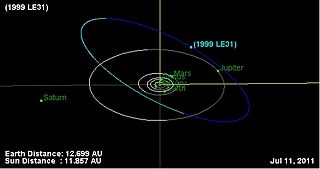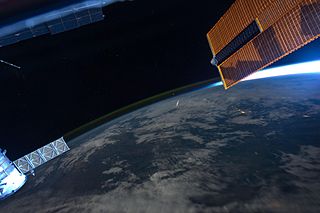Related Research Articles

4179 Toutatis is an elongated, stony asteroid and slow rotator, classified as a near-Earth object and potentially hazardous asteroid of the Apollo asteroid and Alinda asteroid groups, approximately 2.5 kilometers in diameter. Discovered by French astronomer Christian Pollas at Caussols in 1989, the asteroid was named after Toutatis from Celtic mythology.

(29075) 1950 DA, provisional designation 1950 DA, is a risk-listed asteroid, classified as a near-Earth object and potentially hazardous asteroid of the Apollo group, approximately 1.1 kilometers in diameter. It once had the highest known probability of impacting Earth. In 2002, it had the highest Palermo rating with a value of 0.17 for a possible collision in 2880. Since that time, the estimated risk has been updated several times. In December 2015, the odds of an Earth impact were revised to 1 in 8,300 (0.012%) with a Palermo rating of −1.42. As of 2022, It is listed on the Sentry Risk Table with the second highest cumulative Palermo rating of −2.05. 1950 DA is not assigned a Torino scale rating, because the 2880 date is over 100 years in the future.

55P/Tempel–Tuttle is a retrograde periodic comet with an orbital period of 33 years. It fits the classical definition of a Halley-type comet with a period of between 20 and 200 years. It was independently discovered by Wilhelm Tempel on December 19, 1865, and by Horace Parnell Tuttle on January 6, 1866.
Damocloids are a class of minor planets such as 5335 Damocles and 1996 PW that have Halley-type or long-period highly eccentric orbits typical of periodic comets such as Halley's Comet, but without showing a cometary coma or tail. David Jewitt defines a damocloid as an object with a Jupiter Tisserand invariant (TJ) of 2 or less, while Akimasa Nakamura defines this group with the following orbital elements:
20461 Dioretsa is a centaur and damocloid on a retrograde, cometary-like orbit from the outer Solar System. It was discovered on 8 June 1999, by members of the LINEAR team at the Lincoln Laboratory Experimental Test Site near Socorro, New Mexico, United States. The highly eccentric unusual object measures approximately 14 kilometers in diameter. It was named Dioretsa, the word "asteroid" spelled backwards.
(434620) 2005 VD, provisional designation 2005 VD, is a centaur and damocloid on a retrograde orbit from the outer Solar System, known for having the second most highly inclined orbit of any small Solar System body, behind 2013 LA2. It was the most highly inclined known object between 2005 and 2013. The unusual object measures approximately 6 kilometers in diameter.

Minimum orbit intersection distance (MOID) is a measure used in astronomy to assess potential close approaches and collision risks between astronomical objects. It is defined as the distance between the closest points of the osculating orbits of two bodies. Of greatest interest is the risk of a collision with Earth. Earth MOID is often listed on comet and asteroid databases such as the JPL Small-Body Database. MOID values are also defined with respect to other bodies as well: Jupiter MOID, Venus MOID and so on.

1999 XS35 is a near-Earth object discovered in 1999 having a comet-like orbit. Its semi-major axis is 17.8 AU. Its orbital eccentricity is 0.94, which means that at the perihelion 1999 XS35 comes as close as 0.9 AU to the Sun, while at the aphelion it reaches beyond the orbit of Neptune. 1999 XS35 is a damocloid. 1999 XS35 is a small object with an absolute magnitude (H) of 17.2, which implies a size of about 1 km.

(612093) 1999 LE31, prov. designation: 1999 LE31, is a centaur and damocloid on a retrograde and eccentric orbit from the outer region of the Solar System. It was first observed on 12 June 1999, by astronomers with the LINEAR program at the Lincoln Lab's ETS near Socorro, New Mexico, in the United States. The unusual object measures approximately 17 kilometers (11 miles) in diameter.
(7888) 1993 UC is a near-Earth minor planet in the Apollo group. It was discovered by Robert H. McNaught at the Siding Spring Observatory in Coonabarabran, New South Wales, Australia, on 20 October 1993. The asteroid has an observation arc of 23 years and has a well determined orbit. Its estimated size is 2.3 to 5.2 km.

Comet Swift–Tuttle is a large periodic comet with a 1995 (osculating) orbital period of 133 years that is in a 1:11 orbital resonance with Jupiter. It fits the classical definition of a Halley-type comet, which has an orbital period between 20 and 200 years. The comet was independently discovered by Lewis Swift on July 16, 1862 and by Horace Parnell Tuttle on July 19, 1862.
In observational astronomy, the observation arc of a Solar System body is the time period between its earliest and latest observations, used for tracing the body's path. It is usually given in days or years. The term is mostly used in the discovery and tracking of asteroids and comets. Arc length has the greatest influence on the accuracy of an orbit. The number, spacing of intermediate observations, and timestamps have a lesser effect.

2005 HC4 is the asteroid with the smallest known perihelion of any known object orbiting the Sun (except sungrazing comets). Its extreme orbital eccentricity brings it to within 0.071 AU of the Sun (23% of Mercury's perihelion) and takes it as far as 3.562 AU from the Sun (well beyond the orbit of Mars). Due to its very small perihelion and comparably large aphelion, 2005 HC4 achieves the fastest speed of any known asteroid bound to the Solar System with a velocity of 157 km/s (565,000 km/h; 351,000 mi/h) at perihelion (there are comets, however, which obtain much higher speeds).
2002 RN109 is a trans-Neptunian object and damocloid on a highly eccentric, cometary-like orbit. It was first observed on 6 September 2002, by astronomers with the Lincoln Near-Earth Asteroid Research at the Lincoln Lab's ETS near Socorro, New Mexico, in the United States. The unusual object measures approximately 4 kilometers (2 miles) in diameter. It has the second highest orbital eccentricity of any known minor planet, after 2005 VX3.
2000 DG8 is a dark centaur and damocloid on a retrograde and highly eccentric orbit from the outer region of the Solar System. It was first observed on 25 February 2000, by astronomers with the LINEAR program at the Lincoln Lab's ETS near Socorro, New Mexico, United States. It has not been observed since 2001. The unusual object measures approximately 16 kilometers (9.9 miles) in diameter.

2016 WF9 is a dark, sub-kilometer asteroid and suspected extinct comet, classified as near-Earth object and potentially hazardous asteroid of the Apollo group.

2017 OO1 is a small asteroid, classified as near-Earth object of the Aten group, approximately 35–76 meters (115–249 feet) in diameter. It was first observed on 23 July 2017, by the robotic ATLAS survey at Mauna Loa Observatory, Hawaii, two days after the object had approached Earth at 0.33 lunar distances on 21 July 2017.
2017 SN16, is a sub-kilometer asteroid, classified as a near-Earth object of the Apollo group, approximately 90 meters (300 feet) in diameter. The object was first observed on 24 September 2017, by cometary discoverer Alex Gibbs with the Mount Lemmon Survey at Mount Lemmon Observatory, Arizona, in the United States. It forms an asteroid pair with 2018 RY7 and is currently trapped in a 3:5 mean motion resonance with Venus.

2018 WV1 is a very small asteroid and near-Earth object of the Apollo group that passed within 27,000 kilometers (17,000 miles) of the Earth's surface on 2 December 2018. It was first observed on 29 November 2018 by Hannes Gröller with the Catalina Sky Survey at Catalina Station on Mount Bigelow, Arizona, in the United States.
References
- 1 2 3 4 5 6 7 "(343158) Marsyas". Minor Planet Center. Retrieved 18 May 2021.
- 1 2 3 "MPEC 2009-J04 : 2009 HC82". IAU Minor Planet Center. 1 May 2009. Retrieved 18 May 2021.
- 1 2 3 "WGSBN Bulletin Archive". Working Group for Small Bodies Nomenclature. 14 May 2021. Retrieved 16 May 2021. (Bulletin #1)
- 1 2 3 4 5 "JPL Small-Body Database Browser: 343158 Marsyas" (2021-05-18 last obs.). Jet Propulsion Laboratory . Retrieved 18 May 2021.
- 1 2 3 "Asteroid Size Estimator". CNEOS NASA/JPL. Retrieved 26 January 2018.
- ↑ "Date/Time Removed". NASA/JPL Near-Earth Object Program Office. Archived from the original on 2 June 2002. Retrieved 19 March 2012.
- ↑ "NEO Close-Approaches (Between 1900 and 2200)". NASA/JPL Near-Earth Object Program. Archived from the original on 13 December 2012. Retrieved 22 June 2012. (sorted by descending relative velocity, dist<0.5AU = "215,221 close-Earth approaches")
- 1 2 3 "JPL Close-Approach Data: (2009 HC82)" (last observation: 2010-04-04). Retrieved 9 February 2011.
- ↑ "JPL Close-Approach Data: 1P/Halley" (last observation: 1994-01-11). Retrieved 9 February 2011.
- ↑ "JPL Close-Approach Data: 55P/Tempel-Tuttle" (last observation: 1998-07-05). Retrieved 9 February 2011.
- ↑ Akimasa Nakamura and bas (2 May 2009). "List of Damocloids (Oort cloud asteroids)". Lowell Observatory. Retrieved 9 February 2011.
- 1 2 Greenstreet, Sarah; Ngo, Henry; Gladman, Brett (January 2012). "The orbital distribution of Near-Earth Objects inside Earth's orbit" (PDF). Icarus. 217 (1): 355–366. Bibcode:2012Icar..217..355G. doi:10.1016/j.icarus.2011.11.010. hdl:2429/37251.
There are two known retrograde NEAs: 2007 VA85 (a = 4.226 AU, e = 0.736, i = 131.769°) and 2009 HC82 (a = 2.528 AU, e = 0.807, i = 154.519°).
- 1 2 Greenstreet, Sarah; Gladman, Brett; Ngo, Henry; Granvik, Mikael; Larson, Steve (April 2012). "Production of near-Earth asteroids on retrograde orbits" (PDF). The Astrophysical Journal Letters. 749 (2): L39–L43. Bibcode:2012ApJ...749L..39G. doi:10.1088/2041-8205/749/2/L39. S2CID 121886308.
2009 HC82, on the other hand, is on an orbit very near the 3:1 resonance (where it most likely flipped) for the entirety of both independent 1 Myr integrations of the best-fit orbit. This behavior is exactly like the typical steady-state retrograde NEA evolution we discovered.